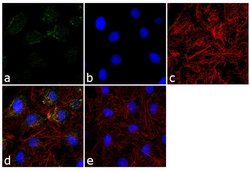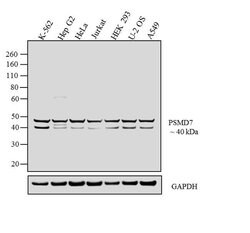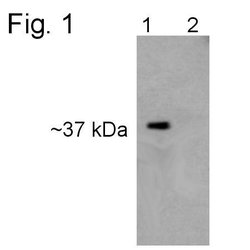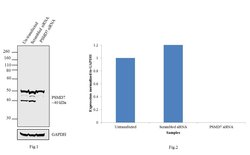Learn More
Invitrogen™ PSMD7 Polyclonal Antibody
Rabbit Polyclonal Antibody
Supplier: Invitrogen™ PA11963
Description
PA1-1963 detects proteasome 19S subunit S12 from human, rat, mouse and hamster cell lysates. PA1-1963 has been successfully used in Western blot procedures. By Western blot, this antibody detects an ~37 kDa protein representing proteasome 19S subunit S12 from human, rat, mouse, and hamster cell extracts. An additional unknown band is detected at ~48 kDa in some cell lysates. PA1-1963 immunogen is a synthetic peptide corresponding to residues A(55) V P F D E D D K D D S(66) C of human 19S subunit S12. The immunizing peptide sequence is 100% conserved in Danio rerio and 91% conserved in Drosphila, C. elegans and Anopheles. PA1-1963 immunizing peptide (Cat. # PEP-211) is available for use in neutralization and control experiments.
Proteolytic degradation is critical to the maintenance of appropriate levels of short-lived and regulatory proteins as important and diverse as those involved in cellular metabolism, heat shock and stress response, antigen presentation, modulation of cell surface receptors and ion channels, cell cycle regulation, transcription, and signaling factors. The ubiquitin-proteasome pathway deconstructs most proteins in the eukaryotic cell cytosol and nucleus. Others are degraded via the vacuolar pathway which includes endosomes, lysosomes, and the endoplasmic reticulum. The 26S proteasome is an ATP-dependent, multisubunit (approximately 31), barrel-shaped molecular machine with an apparent molecular weight of approximately 2.5 MDa. It consists of a 20S proteolytic core complex which is crowned at one or both ends by 19S regulatory subunit complexes. The 19S regulatory subunits recognize ubiquitinated proteins and play an essential role in unfolding and translocating targets into the lumen of the 20S subunit. An enzymatic cascade is responsible for the attachment of multiple ubiquitin molecules to lysine residues of proteins targeted for degradation. Several genetic diseases are associated with defects in the ubiquitin-proteasome pathway. Some examples of affected proteins include those linked to cystic fibrosis, Angelman's syndrome, and Liddle syndrome.
Specifications
| PSMD7 | |
| Polyclonal | |
| Unconjugated | |
| Psmd7 | |
| 26S proteasome non-ATPase regulatory subunit 7; 26S proteasome non-ATPase regulatory subunit 7-like protein; 26S proteasome regulatory subunit rpn8; 26S proteasome regulatory subunit S12; AW107203; Moloney leukemia virus-34 proviral integration; Mov34; Mov-34; Mov34 homolog; Mov34 protein; Mov34 protein homolog; MOV34L; P40; proteasome (prosome, macropain) 26S subunit, non-ATPase, 7; proteasome (prosome, macropain) 26S subunit, non-ATPase, 7 (Mov34 homolog); proteasome 26S non-ATPase subunit 7; proteasome 26S subunit, non-ATPase 7; proteasome subunit p40; Psmd7; Rpn8; S12; wu:fi03c01; zgc:55284 | |
| Rabbit | |
| Antigen affinity chromatography | |
| RUO | |
| 100761962, 17463, 307821, 5713 | |
| -20°C, Avoid Freeze/Thaw Cycles | |
| Liquid |
| Western Blot, Immunocytochemistry | |
| 1 mg/mL | |
| PBS with 1mg/mL BSA and 0.05% sodium azide | |
| P26516, P51665 | |
| Psmd7 | |
| Synthetic peptide corresponding to residues A(55) V P F D E D D K D D S(66) C of human 19S subunit S12. | |
| 100 μg | |
| Primary | |
| Human, Mouse, Rat, Hamster | |
| Antibody | |
| IgG |
Your input is important to us. Please complete this form to provide feedback related to the content on this product.




